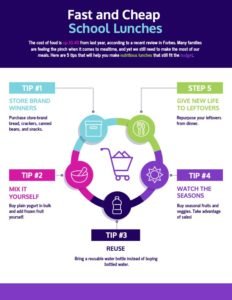Fast and Cheap School Lunches
Holy grocery bills Batman! The cost of food is up 10.4% from last year, according to a recent review in Forbes. 1 Many families are feeling the pinch when it comes to mealtime. The pandemic, rising fuel costs, climate change, government subsidies, increased meat consumption, and world trade organization stockpile limits all play a part in the bump in food costs and there seems to be no relief in sight.Yet we still need to feed our families and make the most of our meals. Lunch is no exception. Programs like the National School Lunch Program offered by the US Dept. of Agriculture are a way for kids to obtain free or reduced-cost lunches. According to the USDA, 30 million students are eligible for the National School lunch program. 2In our new series, Let's Get Kids Healthy, we’ve discussed the impact of common foods and the top 10 nutrients for kids. Now lettuce look at lunch!Why Lunch Matters:Lunchtime can be stressful for kids. Despite it being a “break” in the day, most kids have 30 minutes or less to find their friends, a seat, and decent food to eat. Long lunch lines and not-so-healthy choices often keep kids from getting adequate “food in their food.”Fortunately, food quality for school lunches has improved. Based on school menu data of schools participating in the National School Lunch Program, healthy eating index scores were compiled. From school years 2009-2019 and 2014-2015, school lunch scores went from 58% to 82%. Lunch component scores for whole grains, greens, and beans increased by 20%. Nutritional analysis indicates that meals are better at meeting Dietary Guidelines than previously. 3The midday meal is important to refuel for learning and maintain good nutrition. A 2018 study evaluating the association between frequency and participation in the National School Lunch and Breakfast Program and children’s intake found that those that consumed lunch had higher milk and calcium intakes than those who didn’t. Intake of fruit was higher in those utilizing school breakfast. 4Pack It Up!Another option is packing lunch. This gives parents and students more control over healthy food choices and provides children with more time to actually eat their lunches. Educating children early about nutritious food to pack in their lunches is key.Similar to breakfast, lunch should include complex carbohydrates (whole grain bread, buns, or crackers), protein (turkey, hummus, tuna, or nut/seed butter), and some produce (fresh veggies and fruit). Don’t forget a water bottle! Hydration is key to good health, too.Save Money on Lunch:
- Repurpose leftovers from dinner.
- Pack snacks in reusable containers instead of plastic bags (it's better for the environment too).
- Purchase store-brand bread, crackers, canned beans, and snacks.
- Make your own hummus.
- Buy seasonal fruits and veggies. Take advantage of sales!
- Bring a reusable water bottle instead of buying bottled water.
- Buy plain yogurt in bulk and add frozen fruit yourself.
- Make trail mix with dried cereal, nuts or seeds, and dried fruit
Save Time with Speedy Lunches:
- Peanut butter, banana, and honey on whole wheat bread with grapes or tangerines.
- Black bean and shredded cheese pinwheels using whole wheat tortillas. Add grape tomatoes or pepper strips on the side.
- Hard-cooked eggs with whole grain crackers, carrot sticks, and a banana.
- Chili or soup packed in a thermos. Include whole grain crackers and dates or raisins.
- Hummus and whole grain pita chips with sliced cucumbers and celery sticks.
- Last night’s chicken packed in a pita with spinach and cucumbers with apple slices on the side.
- Leftover pasta packed in a thermos. Pair with blueberries or strawberries.
- Turkey sandwich on rye or whole wheat bread with sliced cheese. Serve with carrot sticks and fruit.
By Lisa Andrews, MEd, RD, LDReferences:
- Food Price Increases, A Disoriented Consumer, And Unreconciled Supply And Demand: The Post-Covid Reality (forbes.com)
- School Meals | Healthy Schools | CDC
- Gearan EC, Fox MK. Updated Nutrition Standards Have Significantly Improved the Nutritional Quality of School Lunches and Breakfasts. J Acad Nutr Diet. 2020 Mar;120(3):363-370. doi: 10.1016/j.jand.2019.10.022. Epub 2020 Jan 13. PMID: 31948795.
- Au LE, Gurzo K, Gosliner W, Webb KL, Crawford PB, Ritchie LD. Eating School Meals Daily Is Associated with Healthier Dietary Intakes: The Healthy Communities Study. J Acad Nutr Diet. 2018 Aug;118(8):1474-1481.e1. doi: 10.1016/j.jand.2018.01.010. Epub 2018 Mar 17. PMID: 29555435; PMCID: PMC6064655.
Free Handout: School Lunch on a Budget


